How Famous NASA Scientists find Inspiration in Hindu God Shiva
As one of the world's leading space agencies, NASA has been at the forefront of important discoveries and scientific advances for decades. Its scientists have helped us to understand the universe and its mysteries in a deeper way. However, many may not know that some of NASA's most famous scientists draw inspiration not only from the universe but also from the Hindus Cosmos, specifically the Hindu God Shiva.
In Hinduism, Lord Shiva is known as the god of destruction and transformation. He is often depicted with a third eye, which represents his power of perception, and a crescent moon on his forehead, which symbolizes the timelessness of the universe. Shiva is also associated with meditation, yoga, and cosmic energy. This combination of qualities has made him an inspirational figure to many NASA scientists, who see a connection between his scientific work and the mysteries of the universe that Shiva symbolizes.
One of the most prominent NASA scientists who has spoken about his reverence for Lord Shiva is Dr. Kamlesh Lulla. Lulla is a former NASA scientist and an expert in space exploration and planetary science. He has talked about how he draws inspiration from Hindu mythology and how it has influenced his work. In an interview with India Abroad, he said, "Lord Shiva is the god of transformation, and that's what we do at NASA. We transform space into knowledge and knowledge into action."
 |
The king of Dance Nataraja Shiv |
Dr. Lulla is not alone in his beliefs. Other NASA scientists have also found inspiration from Lord Shiva and his teachings. For example, Dr. Deepak Basu, an engineer who worked on the Apollo program, has written extensively about his love for Lord Shiva and how it influenced his work. He has said that Shiva's teachings on the cyclical nature of life and death have helped him see the bigger picture and approach his work from a more holistic perspective.
The relationship between NASA scientists and Lord Shiva is not just spiritual. It is also rooted in science. Hindu mythology is full of stories and allegories that are deeply connected to the natural world and the universe. For example, the story of the Samudra Manthan, which tells of the churning of the ocean of milk to obtain the elixir of immortality, is often interpreted as an allegory of the process of evolution. Similarly, Shiva's third eye is seen as a symbol of the power of perception, which is essential for scientists trying to understand the mysteries of the universe.
Shiva Nataraja Statue at CERN
The Nataraj Statue, also known as the CERN Shiva, is a 2-meter-tall bronze statue of the Hindu deity Shiva in his form as the Lord of the Dance. The statue is located at the European Organization for Nuclear Research (CERN) in Geneva, Switzerland, and was gifted to the organization in 2004 by the Indian government.
The statue depicts Shiva in his cosmic dance of destruction and creation, with his four arms representing various aspects of the universe. The statue is placed outside the CERN headquarters, and some people have interpreted its presence there as a symbol of the interconnectedness of science and spirituality.
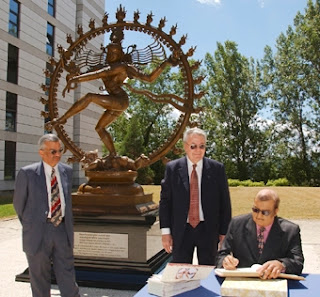 |
| Shiva Nataraj Statue at CERN |
However, the statue has also been the subject of controversy and criticism, with some people claiming that it is inappropriate to have a religious symbol in a scientific institution. Others have argued that the statue misrepresents Shiva and Hinduism and that its placement at CERN is insensitive given the history of Western colonialism in India.
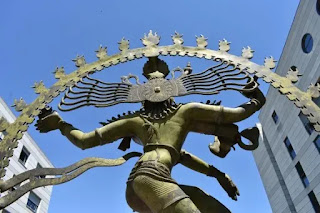 | |
|
Despite the controversy, the Nataraj Statue remains a prominent landmark at CERN and continues to spark discussions about the intersection of science, religion, and cultural representation.
Shiva does cosmic dance and this is called His Lord Nataraja form (Nataraja means King of the dance art).
Shiva in His Nataraj form is shown in the Mudra, standing on a body.
That is not a baby’s body, but the Asur called Apasmara.
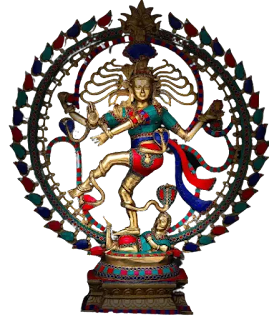 |
| The Cosmic Dance of Shiva |
The statue captures Shiva performing the Tandava, a dance believed to be the source of the cycle of creation, preservation, and destruction. The dance exists in five forms which shows the cosmic cycle from creation to destruction:
- 'Srishti' - creation, evolution
- 'Sthiti' - preservation, support
- 'Samhara' - destruction, evolution
- 'Tirobhava' - illusion
- 'Anugraha' - release, emancipation, grace
What is Shiva showing us through his Nataraj dance?
Nataraj form is the Cosmic dance of Shiva.
The dance is also called Pralaya, the dissolution of everything that exists has to dissolve into Him / the energy.
This shows that Energy can neither be created nor destroyed, it only transforms from one form into another.
In the Nataraj Mudra, we can see Shiva standing in the middle, with the fire spikes around Him.
Shiva has the Dhamarukam in one hand, symbolizing the rhythm of time and sound.
On the other hand, Shiva holds the fire/flame, which conveys the creation and destruction of this world.
And the other hand shows the Abhaya_ Hastha, which means Shiva was present before anything existed and will be there, even when everything is destroyed, and He is the protector too.
Shiva’s face shows fearlessness because nothing is forever, everything created has to be destroyed and thus paves a way for a new beginning. So, we neither lose nor gain anything in this illusion called life.
The connection between NASA's famous scientists and Lord Shiva is a fascinating one that speaks to the intersection of science and spirituality. While NASA's scientists are known for their groundbreaking work in the field of space exploration, their reverence for Lord Shiva and his teachings reveals a deeper connection to the mysteries of the universe that goes beyond scientific discovery. By drawing inspiration from Hindu mythology, these scientists are able to approach their work with a more holistic perspective and a deeper understanding of the universe they seek to understand.



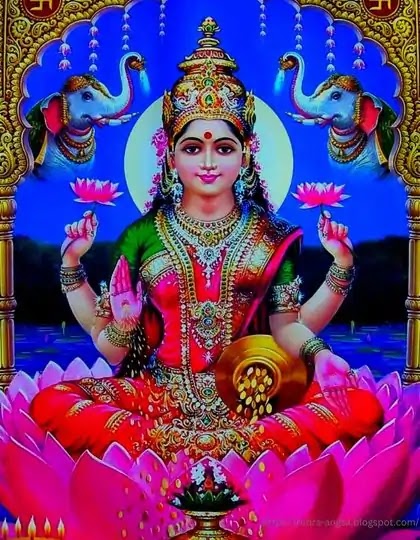

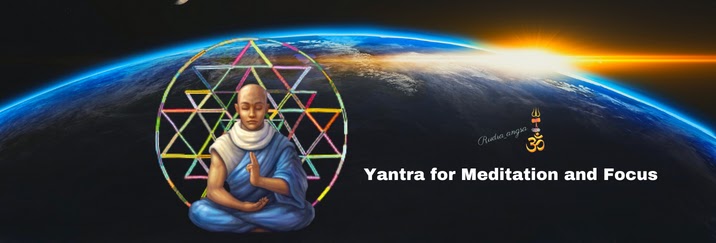
.webp)
